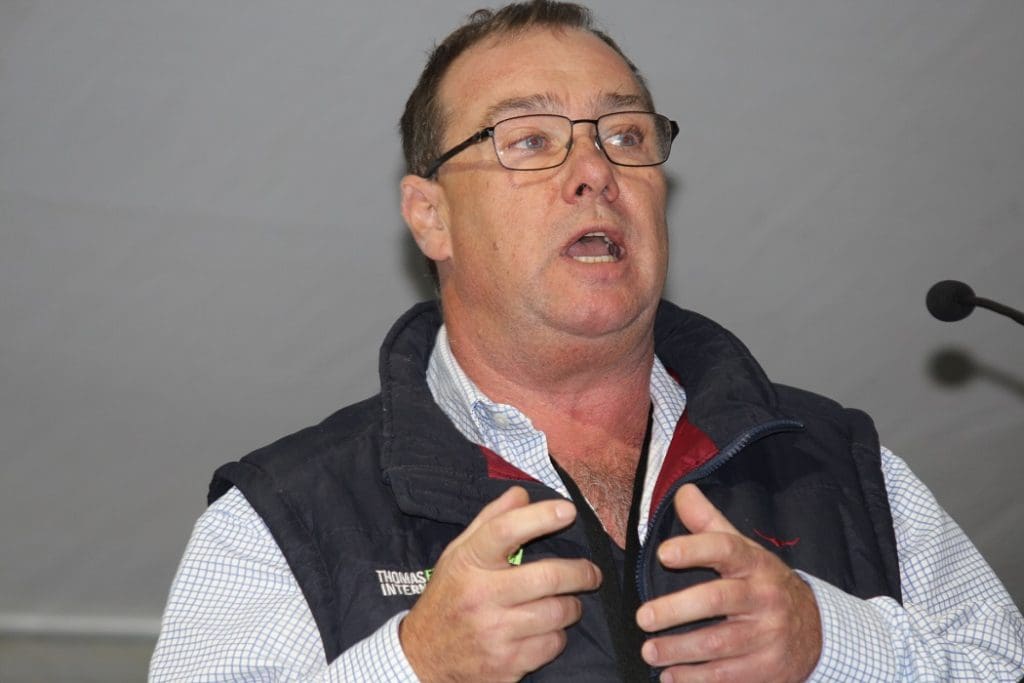
TFI farm assurance and supply chain manager Mark Inglis
LIVESTOCK producers will need an easily adopted and managed “silver bullet” to achieve substantive sustainable carbon emission reductions on farms, Paraway’s ‘Net Zero: Better for Business’ field day was told last week.
Thomas Foods International’s farm assurance and supply chain manager Mark Inglis said the expectation of TFI’s customers is that the products the company sells will be “net zero.”
“They do not want to inherit anything.”
He said TFI’s US operations have done their emissions baselines and the Australian operations were now being baselined. The company’s Australian and our overseas customers are now asking for that information and wanting to know what TFI’s Scope 1, 2 and 3 emissions are.
Mr Inglis TFI’s Scope 1 and 2 emissions can be handled, but it was the Scope 3 emissions that it could not manage.
“The work done in the US showed us that 98pc of the carbon emissions of our US business came from the meat that we actually bought in.
“So something that is out of hands makes up 98pc of our carbon emission total in our business.”
He said high-end analysis of the Australian business showed that 96pc of the emissions is in the livestock that TFI buys in.
“Based on the carbon price at the moment, which is around $30 a tonne – if we were to offset that as a company we are talking $85 million a year.
“Do you think we are going to get that back from our customers?” he asked.
“Are our customers going to pay that, I don’t know the answer to that to be honest.”
Mr Inglis said the current tools to lower emission intensity included optimising on-farm productivity, through better genetics, quicker turn-off rates, increased weaning rates, decreased mortality, deep rooted perennial pastures, grazing rotations increase legumes, increase , technology supplements are great for the feedlot industry.
“But for out on the farm how do we get around that?”
“We haven’t got the silver bullet and to be honest, if we are going to go net zero from a producer or livestock perspective we need a silver bullet,” he said.
“We need something that fits into your management systems that’s too difficult for producers to adhere to or to manage throughout the year.
Mr Inglis said applying all the current productivity tools could yield a 20-30pc reduction in on-farm carbon emissions.
“These are all part of the story going forward, but they are certainly not all of it.”
“We will need money invested in R&D going forward to try to find something that is easy to manage on farm and fits into your normal management system — we’ll need a silver bullet,” he said.
Mr Inglis said current technologies will give reductions of emissions on farms, but they won’t give a total reduction in carbon emissions.
“It’s the 20:60:20 rule, there will be 20pc of producers that will live it, love it, breathe it, do it, there will be 20pc of producers that rally don’t care and just won’t do it and then there is the 60pc in the middle that we need to try to convince.
“So whatever we do in this space needs to fit into what they currently do,” he said.
“I haven’t got the answers, it may well it’s a bullet that we do put down their throat that sits in their stomach to reduce carbon emissions over that period of time.
“I don’t think we’ve come up with it as yet, but I think we certainly need some work,” Mr Inglis said.
“We’ve got to make easy for producers and industry – we shouldn’t be making it harder for us to do this.”
Mr Inglis said the biggest challenge of TFI in the carbon space was the requirement to report Scope 1, Scope 2 and Scope 3 emissions by 2025, not only to the Australian Government but also to our customers up the chain.
“Current there is no mechanism to be able to do that.”
Mr Inglis said in New Zealand since 2022 all livestock producers have had to put their data into a program to get annual carbon emission and intensity figures.
“In Australia how do we as a processor get the transfer of information from producers to the processor so that we can then report it up?”
He hoped Australia would adopt a similar program to that which has operated in New Zealand and said there was a need for common carbon calculators and platforms.

HAVE YOUR SAY